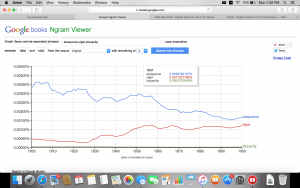I would just like to say that this assignment has finally provided a use for Letters of Note, that fun, enormous and not to mention expensive book that freshmen were told we need in order to survive first semester. Yet, it has done nothing but sit on my bookshelf and collect dust. Though today I pulled the monstrous novel off the shelf, thumbed the pages until found a series of letters written from 1823 to 1897. From there, randomly selected the first word I saw. This lead me to the words, eloquence, vigor and loquacity. Eloquence is a noun, by definition in context to the letter “fluent or persuasive speaking or writing.” Vigor is also a noun and again in context means “physical strength and good health.” Vigor can also mean, “legal and binding force.” The last word was entirely new to me; Loquacity, is a noun that means “the quality of talking a great deal; talkativeness.”
It is hard to say exactly why these words either increased or decreased in popularity over the century. I did some research and was led to a few different conclusions. For eloquence, I believe that it was more popular in the beginning of the 18th century because of Victorian or “turn of the century” writing. The word itself sounds snazzy, eloquence, therefore if an individual were to describe a narrative spoken by perhaps a heroic character then the author would want connotation and diction to match the prose. This is a common rhetorical strategy still used today just with more relatable words of the time period. Perhaps the decrease in popularity comes from stylistic changes in writing leading into the 19th century.
Vigor, unlike eloquence actually gains popularity towards the end of the century. This I believe, is for similar reasons, the change in writing styles. Vigor is simple, and doesn’t seem to lose its effectiveness as a noun. Today we still describe things as vigorous. Where if we wanted to describe the persuasiveness of a speaker, we would say persuasive, not eloquence. It’s all about time and styles of that time.
Lastly, the word loquacity. While researching I found next to nothing in regards to this funky word. It was most popular in the beginning of the 18th century. I use ‘most popular’ loosely. Even then it’s popularity is like a Highschool Sports column, written by the coach of the team, for the high school newspaper, with a total of 10 copies printed, left to read at leisure if you are bored with sleeping in detention; in comparison to Vouge. Loquacity, is an ugly word. I know that is crude but I believe that is why it was and will forever be, unpopular and scarcely used.
Sources: Google Dictionary, Google Ngram, http://www.brachcollective.org/, Letters of Note Here is the screenshot!!!!
Here is the screenshot!!!!
Really cool that you found a use for the book that we all paid so much money for and barely used!